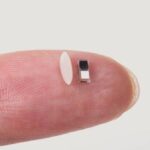Please welcome back Ellie Gabel to the 21st Century Tech Blog. This is Ellie’s sixth contribution to the blog site. To learn more about her and her writing, you can visit her website.
In this article, Ellie writes about the challenges of manufacturing things at the nanoscale. Nanoscale refers to dimensions between 1 and 100 nanometers (nm). How small is a nanometer, a billionth of an inch? For perspective, a human hair is between 80,000 and 100,000 nanometers wide. A strand of DNA’s diameter measures 2.5 nanometers.
Let Ellie describe the current and future challenges when manufacturing at such a small scale.
Manufacturing nanoscale electronics presents big challenges. These devices and components are built at a nanometer scale, where materials behave oddly because of their size. Nanometer manufacturing is used to build incredibly compact, high-performance chips that are more powerful and energy-efficient. This is the technology that empowers artificial intelligence (AI) and enables smarter algorithms and faster data processing.
Nanoscale devices are also foundational to advancing quantum computing from theory to practical reality. Nanoscale structures like quantum dots and nanowires enable precise manipulation of quantum states.
In semiconductors, nanoscale advancements push the boundaries of what’s possible in mobile devices, wearables, autonomous systems and more.
As demand grows for faster, smaller and more intelligent electronics, nanoscale engineering is becoming the foundation of tech breakthroughs.
The Limits of Conventional Manufacturing Tools
In 2021, nanotechnology was the focus of the semiconductor manufacturing sector, accounting for 50% of research and development (R&D) funding. Manufacturers continue to spend billions on shrinking components further with traditional lithography methodologies approaching their physical limits, making it harder to maintain the precision required for consistent results.
At the nanoscale, even the tiniest variation in material thickness or placement can cause a device to fail. Something as small as a dust particle can destroy nanostructures, necessitating clean-room fabrication environments.
Material Challenges at the Atomic Scale
Nanoscale materials behave in ways that defy expectations. Even atomic-level imperfections, like a missing atom or a slightly misaligned layer, can lead to performance issues or total failure. On a nanoscale, properties like conductivity, heat resistance and strength don’t always follow the rules of large-scale electronics, adding complexity to design and fabrication. As engineers design more compact and powerful chips and electronic devices, the room for error shrinks dramatically, making ultra-precise control and constant innovation in tools, materials and processes essential.
Electrostatic discharge is a major threat in nanoscale manufacturing. Components are so sensitive that even a static electricity spark can destroy them. The common cause of static discharges is the human body, with daily actions such as walking across a floor or removing a sweater, potentially generating thousands of volts that can easily be transferred upon contact. At nano-manufacturing sites, manufacturers install electrostatic dissipative flooring to ground electrical charges and reduce static buildup. This simple and vital solution helps to create a safe, stable environment for producing the next generation of electronics.
Scaling Production
Scaling presents a major challenge in nanoscale manufacturing. What works perfectly in a research setting often runs into roadblocks during mass production, where consistency, cost and efficiency come into play. Cutting-edge tools like extreme ultraviolet lithography create ultra-fine features. Still, they’re expensive and only available at several facilities worldwide.
Even with access to top-tier equipment, manufacturers struggle with high failure rates, as tiny inconsistencies during fabrication can render entire batches unusable. The margin for error is so small that scaling up requires massive investment in tools, clean room environments and constant process refinements to maintain quality results. These barriers make it difficult to bring nanoscale innovations to market quickly, highlighting the gap between research success and commercial viability.
Quantum Effects and Unpredictable Behaviour
One major issue in nanoscale electronics is quantum tunnelling. Electrons can jump across barriers they’re not supposed to, leading to current leakage and unreliable performance. When the dimensions of the electronics shrink, components are more tightly packed, creating thermal management challenges and escalating power density. The smaller the device, the harder it becomes to dissipate heat effectively, and overheating can lead to failure.
Engineers must also contend with increased signal interference known as crosstalk. Crosstalk occurs in electronic systems when a signal transmitted in one circuit, wire, or channel unintentionally induces interference in a neighbouring circuit, wire, or channel. The likelihood of this occurrence becomes more pronounced as the distance between the components decreases, making it tougher to ensure clean, accurate data transmission. This “noise” demands new design strategies to make nanoscale devices stable, efficient and functional.
Ethical and Environmental Considerations
Nanoscale electronics are introducing exciting possibilities, but with them come safety concerns. Some materials in these devices, especially those involving engineered nanoparticles, may pose health risks to workers during production and to end users over time. Research suggests that exposure to certain nanoparticles can lead to oxidative stress, DNA damage and cell death.
From a disposal and recycling perspective, nanoscale manufacturing is poorly regulated, posing long-term risks to ecosystems and communities. As the industry advances, public trust will depend on how responsibly these materials are handled. Transparent research, strict safety protocols and proactive regulation ensure that progress in nanotechnology doesn’t come at the cost of health or sustainability.
Tackling Nanoscale Challenges Matters for the Future
Overcoming the challenges that manufacturers face with nanoscale electronics has produced groundbreaking advances in computing, medicine and energy. Continued investment in R&D can push past the perceived technical limits of today and bring safer, smarter technologies to market as the 21st century unfolds. What will be needed is the collaboration among engineers, scientists and policymakers to ensure that innovation in nanotechnology moves forward responsibly and sustainably.









